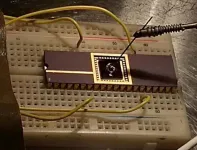(Press-News.org) Tiny plankton – measuring less than 20µm (or 0.02mm) in diameter – make up the majority of plankton in the ocean and play a critical role in the planet’s health, according to new research.
However, scientists say challenges in identifying them have led to them becoming a silent majority that is currently being overlooked when it comes to global ocean policy.
The study is one of the first to explore the abundance and importance of these tiny ocean inhabitants around the UK coastline, with the technology capable of monitoring them only having been introduced in around 2010.
However, that monitoring has shown that in some instances, 99.98% of plankton abundance – and 71% of plankton biomass – is derived from these tiny cells.
The research has also shown they can be impacted directly by changes in ocean temperatures and nutrients, in addition to other environmental shifts taking place as a result of climate change.
Published in the journal Ecological Indicators, the study involved a number of the UK’s leading plankton scientists – including experts from all three of the Marine Research Plymouth partners – and was carried out using cutting edge surveying and identification techniques.
Lead author Dr Abigail McQuatters-Gollop, Associate Professor of Marine Conservation at the University of Plymouth, said: “You hear of phrases like searching for a needle in a haystack, but this takes it to a whole new level. Identifying something that measures 0.02mm in the ocean is an immense challenge, but an increasingly important one at a time of huge environmental pressures. These plankton may be tinier than most people can realistically imagine, but they underpin the entire marine food web and play a critical role in producing the oxygen our planet needs. We need to take this silent majority more seriously.”
Larger plankton have been used for decades to monitor ecosystem productivity and biodiversity, but four UK plankton surveys – including the Marine Biological Association’s Continuous Plankton Recorder survey – have also sampled tiny plankton in the past 14 years.
The researchers involved in the current study used the results of those surveys, which focused on the English Channel and Scottish coast, to investigate six groups of tiny plankton including two groups of heterotrophic bacteria.
Doing that involved a combination of flow cytometry – a laser-based technique used to detect and analyse the chemical and physical characteristics of cells or particles – and light microscopes.
This provided evidence of the abundance of tiny plankton, with that data then being cross-referenced against known changes in environmental conditions to assess how they were being impacted.
As a result, the researchers have recommended that tiny plankton groups should be used to inform biodiversity indicators that meet policy obligations under the EU Marine Strategy Framework Directive (MSFD), (Oslo-Paris Convention) OSPAR strategies, and the UK Marine Strategy.
They have also called for long-term monitoring of tiny plankton across multiple sites to ensure that policy decisions are based on accurate local and global evidence.
Study co-lead Dr Rowena Stern, a CPR Research Fellow at the Marine Biological Association (MBA), added: “We have been able to connect these tiny plankton to meaningful indicators for policy use by measuring how human-driven environmental pressures affect the timing of their growth. This has only been possible by taking consistent, long-term measurements of these types of plankton.”
• The full study – McQuatters-Gollop et al: The silent majority: pico- and nanoplankton as ecosystem health indicators for marine policy – is published in Ecological Indicators, DOI: 10.1016/j.ecolind.2024.111650. It involved researchers from: the University of Plymouth; The Marine Biological Association (MBA); Plymouth Marine Laboratory; Environment Agency; Marine Scotland Science; Centre for Environment, Fisheries and Aquaculture Science (Cefas); Scottish Association for Marine Science.
END
Small but mighty – study highlights the abundance and importance of the ocean’s tiniest inhabitants
2024-02-05
ELSE PRESS RELEASES FROM THIS DATE:
Bullied teens’ brains show chemical change associated with psychosis
2024-02-05
Researchers have found that adolescents being bullied by their peers are at greater risk of the early stages of psychotic episodes and in turn experience lower levels of a key neurotransmitter in a part of the brain involved in regulating emotions. The finding suggests that this neurotransmitter — a chemical messenger that transmits nerve impulses for communication by a nerve cell — may be a potential target for pharmaceutical interventions aimed at reducing the risk of psychotic disorders.
Psychosis is a mental state characterized by loss of contact with reality, incoherent speech and behavior, and typically hallucinations and delusions seen in psychiatric disorders ...
Unlocking precision medicine for inflammatory bowel disease
2024-02-05
The prevalence of inflammatory bowel disease (IBD), encompassing ulcerative colitis (UC) and Crohn's disease (CD), is rapidly increasing worldwide, affecting an estimated 6.8 million people. This surge brings significant economic burdens, with annual healthcare costs exceeding $12,000 and $7,000 for CD and UC patients, respectively. Tailored drug selection based on individual factors can potentially reduce these costs and improve patient outcomes.
Factors associated with a Western lifestyle such as urbanization, high animal protein intake, ultra-processed foods, and reduced fiber ...
High production of polyols using crude glycerol by wild-type safe yeasts
2024-02-05
Utilizing crude glycerol for the synthesis of high-value products offers a promising solution to counter the adverse effects of declining glycerol prices in the biodiesel sector. The prevalence of crude glycerol, a by-product of biodiesel production, across agriculture, biofuel, and industrial sectors is steadily rising. Recent advancements have demonstrated the effectiveness of both wild-type and mutant yeast strains as microbial cell factories capable of converting glycerol into a diverse array of valuable compounds, including microbial oils, sugar-alcohols (polyols), and organic acids. With the projected increase in biodiesel production, there is a need to explore integrated ...
Solvent sieve method sets new record for perovskite light-emitting diodes
2024-02-05
Using a simple solvent sieve method, researchers from the Ningbo Institute of Materials Technology and Engineering (NIMTE) of the Chinese Academy of Sciences (CAS) have taken the lead in developing highly efficient and stable perovskite light-emitting diodes (PeLEDs) with record performance.
The study was published in Nature Photonics.
Perovskites are one of the most promising optoelectronic materials due to their excellent optoelectronic performance and low preparation cost. Compared with traditional organic light-emitting diodes (OLEDs), PeLEDs have a narrower light-emitting spectrum and superior color ...
Combination therapy lowers blood pressure in patients receiving ibrutinib
2024-02-05
(WASHINGTON, Feb. 5, 2024) – Combination treatments with two or more blood pressure drugs can significantly reduce blood pressure in patients taking ibrutinib, according to a new study published in Blood Advances.
Targeted drugs such as ibrutinib have improved outcomes for patients with cancers of the lymphatic system, but patients treated with ibrutinib and other drugs in its class often develop new or worsening high blood pressure (or hypertension or HTN). Few studies have examined how best to treat this potentially serious side effect, nor do any formal guidelines exist to steer doctors toward the most effective treatments.
“To ...
Ultra-sensitive lead detector could significantly improve water quality monitoring
2024-02-05
Engineers at the University of California San Diego have developed an ultra-sensitive sensor made with graphene that can detect extraordinarily low concentrations of lead ions in water. The device achieves a record limit of detection of lead down to the femtomolar range, which is one million times more sensitive than previous sensing technologies.
“With the extremely high sensitivity of our device, we ultimately hope to detect even the presence of one lead ion in a reasonable volume of water,” said Prabhakar Bandaru, a professor in the Department of Mechanical and Aerospace Engineering at the UC San Diego Jacobs School of Engineering. “Lead exposure is a serious health concern, ...
World’s largest childhood trauma study uncovers brain rewiring
2024-02-05
The world’s largest brain study of childhood trauma has revealed how it affects development and rewires vital pathways.
The University of Essex study – led by the Department of Psychology’s Dr Megan Klabunde – uncovered a disruption in neural networks involved in self-focus and problem-solving.
This means under-18s who experienced abuse will likely struggle with emotions, empathy and understanding their bodies.
Difficulties in school caused by memory, hard mental tasks and decision making may also emerge.
Dr ...
Number of shark bites consistent with recent trends, with small spike in fatalities
2024-02-05
There was an increase in the number of unprovoked shark attacks worldwide and an uptick in fatalities in 2023 compared to the previous year. The University of Florida’s International Shark Attack File (ISAF), a scientific database of global shark attacks, confirmed 69 unprovoked bites in 2023. Although this is higher than the most recent five-year average of 63 attacks, the data remain consistent with long-term trends.
Ten of the past year’s unprovoked attacks were fatal, up from five the year before, with a disproportionate number occurring in Australia. Although the country accounted for 22% of all attacks, ...
Schmidt Sciences awards $1.95M gift to Mount Sinai's Windreich Department of Artificial Intelligence and Human Health to establish The Eric and Wendy Schmidt AI in Human Health Fellowship Program
2024-02-05
New York, NY (February 5, 2024) — The Windreich Department of Artificial Intelligence (AI) and Human Health at the Icahn School of Medicine at Mount Sinai announced a transformative $1.95 million gift from Schmidt Sciences to create The Eric and Wendy Schmidt AI in Human Health Fellowship Program. The gift will support an inaugural cohort of five fellows over a three-year fellowship.
By leveraging AI and machine learning to tackle the increasing volume of data in health care, The Eric and Wendy Schmidt AI in Human Health Fellows will play a pivotal role in advancing medical research. ...
NFL PLAY 60 Fitness Break broadcast delivers movement minutes in advance of Super Bowl LVIII
2024-02-05
DALLAS, Feb. 5, 2024 — The American Heart Association and the National Football League (NFL), in collaboration with its 32 NFL clubs, are challenging kids to get moving and PLAY 60 in advance of Super Bowl LVIII with the latest installment of the NFL PLAY 60 Fitness Break broadcast series. On Thursday, February 8 at 1 p.m. ET/ 12 p.m. CT/ 10 a.m. PT the Association and the NFL will deliver an action packed, 15-minute synchronous broadcast to help students add movement to their day leading up to the big game along with ...




